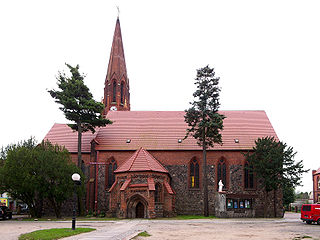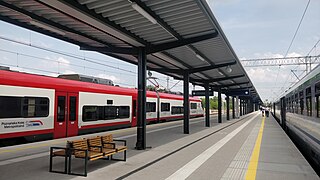Related Research Articles

Rzepin is a town in western Poland. Situated in the Lubusz Voivodeship, in Słubice County it is the seat of Gmina Rzepin. From 1975 until 1998 the town, from an administrative point of view, belonged to the Gorzów Wielkopolski Voivodeship. As of 2019, the town had a population of 6,529 inhabitants.
The Ufa train disaster was a railway accident that occurred on 4 June 1989, in Iglinsky District, Bashkir ASSR, Russian SFSR, Soviet Union, when an explosion killed 575 people and injured 800 more. It is the deadliest rail disaster during peacetime in Soviet/Russian history and the second-deadliest overall after the Vereshchyovka train disaster.
The history of rail transport in Poland dates back to the first half of the 19th century when railways were built under Prussian, Russian, and Austrian rule. Of course, "divided Poland" in the 19th century was the territory of the former Polish–Lithuanian Commonwealth and not that one of today's Republic of Poland. After Polish independence was declared on 11 November 1918, the independent Polish state administered its own railways until control was surrendered to German and Soviet occupiers during World War II.

The Berlin–Wrocław railway was a German private railway that connected Berlin and Wrocław. It is one of the oldest lines in Germany, opened between 1842 and 1847 and acquired by the Prussian government in 1852. In 1920, it became part of the German national railways along with the rest of the Prussian state railways.

The Frankfurt (Oder) station is the main passenger station in Frankfurt (Oder). It is one of the most important railway stations in the German state of Brandenburg. It is served by regional and long-distance services and since 1945 it has been a border station for transport to and from Poland. The station has been substantially rebuilt several times. A building on the grounds of the first Frankfurt station, north of the current station, is heritage-listed, as are the Kiliansberg apartments, which were built as a railway settlement at the station forecourt, and a monument to railwaymen who fell in the First World War in the same area.

Konin railway station is a railway station in Konin, in the Greater Poland Voivodeship, Poland. The station opened in 1921 and is located on the Warsaw–Kunowice railway and Konin–Kazimierz Biskupi railway. The train services are operated by PKP and Koleje Wielkopolskie.

On 4 July 1943, a Liberator II aircraft crashed off Gibraltar shortly after takeoff, killing all but one of the seventeen people on board. Among the victims were several senior Polish military leaders, including General Władysław Sikorski, the commander-in-chief of the Polish Army and prime minister of the Polish government-in-exile. The plane's pilot was the only survivor.

Władysław Sikorski's death controversy revolves around the death of the commander-in-chief of the Polish Army and Prime Minister of the Polish government in exile, General Władysław Sikorski, in the 1943 B-24 crash in Gibraltar. Sikorski's Liberator II crashed off Gibraltar almost immediately after takeoff, with the plane's pilot being the only survivor. The catastrophe, while officially classified as an accident, has led to several conspiracy theories that persist to this day, and often propose that the crash was an assassination, which has variously been blamed on the Soviets, the British, and the Nazis. The incident is still described by some historians as mysterious and was investigated by the Polish Institute of National Remembrance. They concluded that the injuries sustained were consistent with a plane crash and that there was not enough evidence to support or reject the theory that the plane was deliberately sabotaged.

Wawel is a named international express train. Introduced in 1995 as an InterCity service, it was upgraded to EuroCity category by its operators PKP Intercity and DB Fernverkehr in 2006. The service was withdrawn at the end of 2014 but reintroduced in December 2020.

The Strizh is a Russian locomotive-hauled, low-floor, high-speed express train.

The Warsaw–Kunowice railway is a 475-kilometer long railway line in Poland connecting Warsaw, Poznań through Łowicz, Kutno and further to the Polish-German border at Frankfurt an der Oder.

Rzepin railway station is a railway station serving the town of Rzepin, in the Lubusz Voivodeship, Poland. The station is located on the Warsaw–Kunowice railway, Wrocław–Szczecin railway and Wierzbno–Rzepin railway. The train services are operated by PKP Intercity and Polregio.

Świebodzin railway station is a railway station serving the town of Świebodzin, in the Lubusz Voivodeship, Poland. The station is located on the Warsaw–Kunowice railway. The train services are operated by PKP and Przewozy Regionalne.

Zbąszynek railway station is a railway station serving the town of Zbąszynek, in the Lubusz Voivodeship, Poland. The station opened in 1925 and is located on the Warsaw–Kunowice railway, Zbąszynek–Guben railway and Zbąszynek-Gorzów Wielkopolski railway. The train services are operated by PKP, Przewozy Regionalne and Koleje Wielkopolskie.
The Nowy Dwór Mazowiecki train disaster was a railway disaster that occurred in Nowy Dwór Mazowiecki on 22 October 1949.

Railway sabotage was one of the main tactics used by the resistance to German occupation during World War II. Partisans and rail workers used sabotage to harass and confuse the invaders, misdirect, destroy, and lose their troops and supplies, and to damage railroad infrastructure, denying the occupiers its use.
References
- 1 2 3 4 5 6 7 8 "Soviet Train Crash Kills 160". The Arizona Republic . 19 July 1952.
- 1 2 Reader's Digest Almanac and Yearbook, 1971, p. 281
- 1 2 Franklin Henry Hooper and Walter Yust, Britannica Book of the Year 1953 (Encyclopaedia Britannica, 1953), p. 225.
- 1 2 3 4 "Soviet Troop Train Crash". The Guardian . 12 July 1952.
- ↑ "Pig-Headed Russian General Causes 160 Deaths in Wreck". The Berkshire Eagle . 19 July 1952.
- 1 2 3 4 "Russian Express". The LA Times . 19 July 1952. p. 1.
- 1 2 "Russian Express Reported Wrecked by Underground". The Star Press . 20 July 1952.
- ↑ Charles A. Ruud (2009). "Early Travels with Robert Ford, 1952-1953". The Constant Diplomat: Robert Ford in Moscow. McGill-Queen's Press - MQUP. p. 221. ISBN 9780773535855.
- ↑ "How Things Are in Russia Today: Article 2". The Ottawa Citizen . 21 April 1953.
- ↑ Miscellaneous Railroad Information (PDF), Central Intelligence Agency, 3 October 1952, CIA-RDP82-00457R014000330010-3, archived from the original (PDF) on 23 January 2017
- ↑ Pytanie do... - lista, rzepin.pl (April 28, 2009)